| Corcoran Technical Trading Patterns For November 24 |
| By Clive Corcoran |
Published
11/24/2008
|
Stocks
|
Unrated
|
|
|
|
Corcoran Technical Trading Patterns For November 24
A continuation of Friday's rally is to be expected in the early going in Monday's US session. European stocks are rallying on the rescue of Citigroup (C) and perhaps as well as the mini-budget statement due later today from the UK Chancellor.
On the daily chart for the S&P 500 cash index there are two hurdles to overcome - one which I would expect to be challenged today is the 825 area which had until last week marked critical intraday lows, and then higher targets which will run into the descending line which forms part of the downward wedge pattern. This line is tracking the 50-day EMA and has rather a steep slope so projecting it further becomes a matter of factoring in how long it takes, assuming there is a meaningful rally, before the resistance level is met.
It is not inconceivable that we could pierce this line with some more upbeat sentiment in the market for a change. The reasons that the market could celebrate are multi-faceted:
The sword of Damocles (i.e. Citigroup) has been neutralized with a safety net at least in the short term.
There is a perception among certain institutions of confidence in the emerging Obama team
We are in the "holiday" season
The auto companies will almost certainly get a bailout
On the negative side there are a few things to worry about though
According to a Bloomberg report this morning
The U.S. government is prepared to lend more than $7.4 trillion on behalf of American taxpayers, or half the value of everything produced in the nation last year, to rescue the financial system since the credit markets seized up 15 months ago.
Hank Paulson still has six more weeks to go.
The housing market continues to show no signs of approaching a bottom
Those who have had Citigroup in their sights will now start looking elsewhere.
The one thing that I feel very confident about is that there remains a very volatile environment ahead where buy and hold investment strategies will fall even more out of favor.
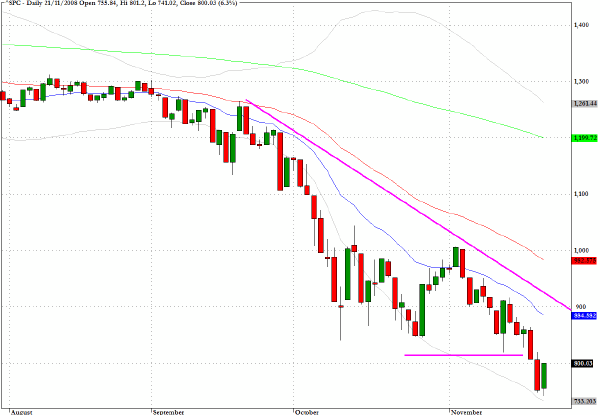
According to press reports in the UK the government is about to launch an aggressive fiscal stimulus package designed to enable the UK economy to spend its way back to prosperity.
It appears from leaks to the press that Value Added Tax, the most conspicuous form of indirect taxation, will be the main vehicle to be adjusted. A reduction of 2.5 percentage points (the maximum allowed for EU members) is being targeted in an attempt to encourage the punters to get out in the stores this Christmas season and do their duty as good consumers. But this approach is looking increasingly desperate especially as there are also suggestions by the current UK Chancellor, in order to show his credentials for prudence to the global capital markets, who still might decide to dump sterling and UK Treasury paper in response to the moves, that in the longer term the working stiffs should expect tax rises in order to pay for these short term emergency measures.
In the long run is this really the solution to the UK’s economic problems? The question is especially acute for the UK economy which has a zero savings rate and some of the highest levels of personal indebtedness in the world. Why are UK policy makers continuing to focus on trying to enhance the marginal propensity to consume when it would be so much better, for the structural economy, in the longer term, to be looking at ways of decreasing the marginal propensity to take on more debt?
Gordon Brown’s proposed new mini-budget along with a host of other recent posturing and antics puts a new focus on the real meaning behind the Clinton saying “It’s the Economy Stupid”. Failure by any politician to be visibly concerned about the plight of the common man, not to be seen to be very busy and doing something active and positive during dire economic times is a recipe for electoral defeat and like Clinton before him Gordon Brown knows this only too well. Much better to be seen rushing to world summits and convening G20 meetings, encouraging the central bank to make emergency rate cuts and having countless initiatives that ultimately tap into public monies to get the economy “moving” again. And alas the UK punters are gullible and would rather a government that appears to be addressing their concerns than providing a sound basis over the longer haul for a more rational economy.
UK government policy is now transitioning from the denial phase where constant reassurances were given that the "fundamentals are sound" (someone should set that to music) to the "let's throw everything including the kitchen sink at it and say our prayers dutifully" phase.
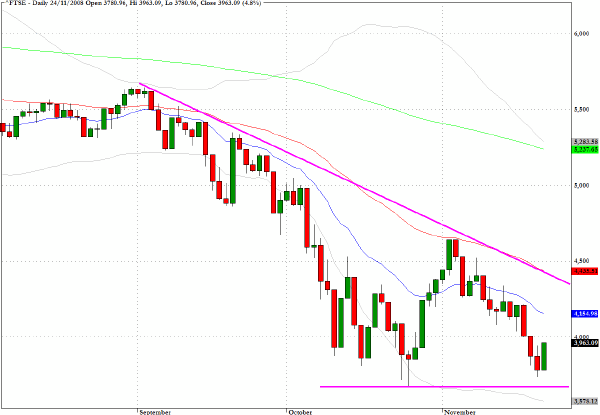
Gold prices catapaulted higher in Friday's session as they broke convincingly through the critical $750 per ounce level. The Gold Index (^GOX) which includes the mining stocks made a sharp move higher and broke free from a well formed triangular/wedge pattern.
This is a market that has a habit of disappointing the bulls almost on an habitual basis so I would caution any enthusiasm until we see how the mining stocks behave in particular as we approach the 50-day EMA on the chart below (the red line).
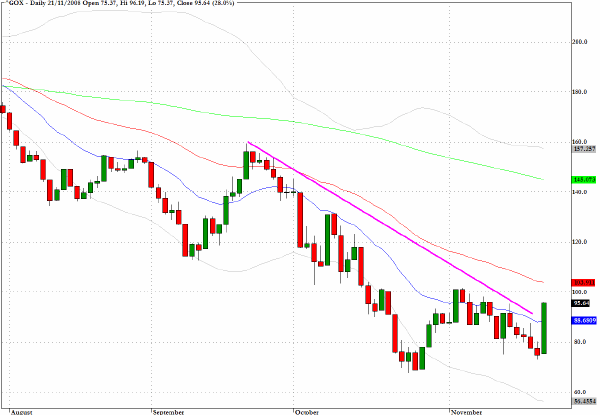
The exchange traded fund DGL provides a long play on gold with two to one leverage and as the chart suggests there is a real test for this fund at $31.
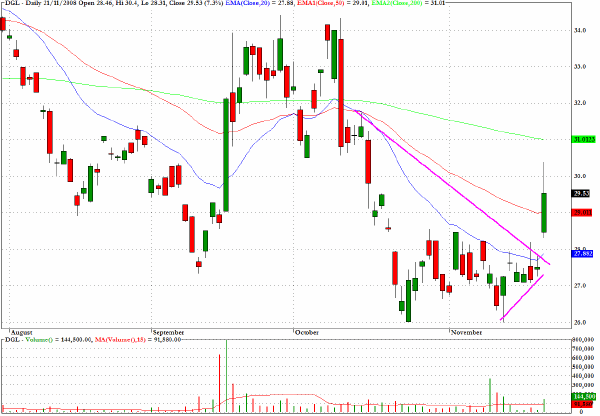
HYG is an ETF which tracks the high yield corporate bond market and as I indicated a couple of weeks ago in this column and in a slot on CNBC the failure at key retracement levels suggested that the mid October lows were back in play. This was confirmed in Friday's trading and I would advise, at this point, that if you had been short recently it would be prudent not to overstay one's welcome.
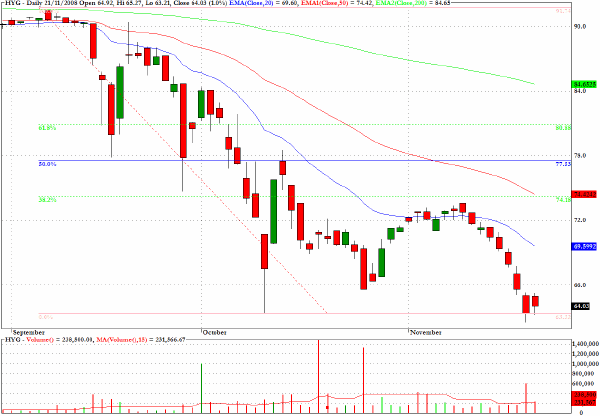
The ETF that tracks the price of emerging sovereign debt, PCY, shows two clear failures at the 50% retracement level from the early September highs to the mid-October lows. More significantly this sector has now dropped below the 38% retracement level.
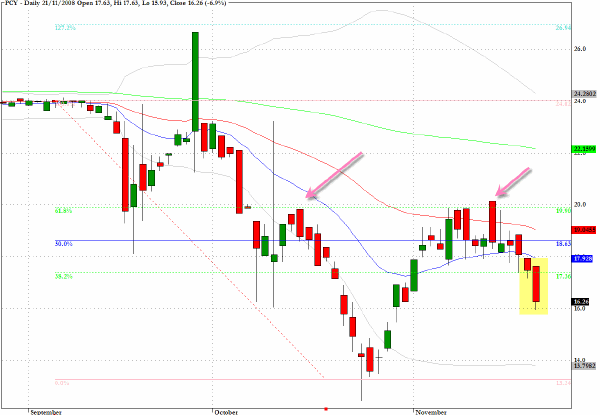
A couple of weeks ago I expressed doubts that there would be a rally in the biotech sector, but now reviewing the chart for the exchange traded fund, IBB, I would suggest that the risk/reward prospects look more encouraging on the long side.
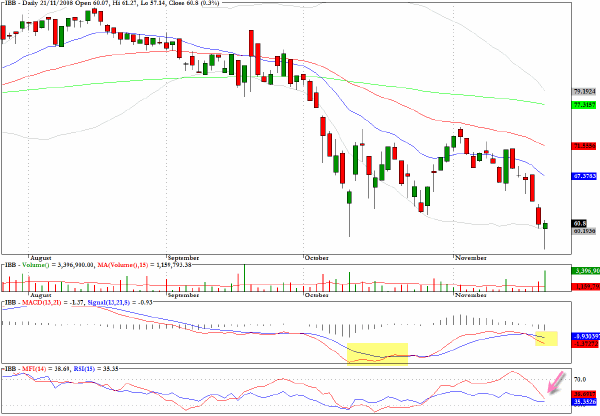
CMF is an exchange traded fund that allows one to express a view on the strength or otherwise of the municipal bonds of the state of California. In Friday's session there was a range expansion and a drop below key moving averages. The volume was not substantial but this will be on my Watch List this week for further signs of weakness.
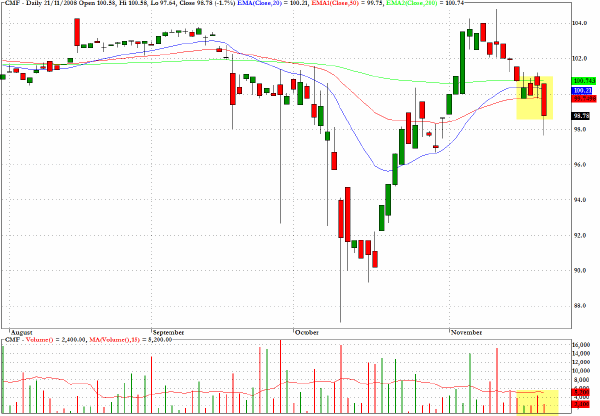
Clive Corcoran is the publisher of TradeWithForm.com, which provides daily analysis and commentary on the US stock market. He specializes in market neutral investing and and is currently working on a book about the benefits of trading with long/short strategies, which is scheduled for publication later this year.
Disclaimer
The purpose of this article is to offer you the chance to review the trading methodology, risk reduction strategies and portfolio construction techniques described at tradewithform.com. There is no guarantee that the trading strategies advocated will be profitable. Moreover, there is a risk that following these strategies will lead to loss of capital. Past results are no guarantee of future results. Trading stocks and CFD's can yield large rewards, but also has large potential risks. Trading with leverage can be especially risky. You should be fully aware of the risks of trading in the capital markets. You are strongly advised not to trade with capital.
|